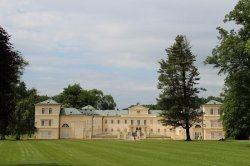Kynžvart Castle
Your travels may one day take you to the town of Lázně Kynžvart, above which stands the ruins of a medieval castle on Hradní vrch. The original castle was built in the 13th century between Špičák and Šibeniční vrch. It served to protect the military and trade routes and was destroyed in July 1347. The ruins of the castle could be repaired with the permission of King Wenceslas IV. until 1398. Under this castle, a Renaissance chateau was built in the valley, the exact former form of which is not yet known. The castle was built in the years 1585 - 1597 and later it was modified in the Classicist and Baroque style.
Information for visitors
Interesting facts Kynžvart Castle
The estate in Kynžvart was confiscated after the Battle of Bílá Hora, lent in 1623 and ceded to the Metternich brothers seven years later. The Imperial Count Filipp Emmerich von Metternich embarked on the Baroque renovation of the dilapidated castle (1681 - 1691). The owners did not stay much at the castle during the 18th century, because their main seat was the Rhineland. Later, they lost their Rhine estates, and from the end of the 18th century, Kynžvart became their only seat. The most famous owner of the Kynžvart castle was Clemens Wenzel Lothar Johann Nepomuk, the second prince von Metternich-Winneburg. He lived from 1773 to 1859 and during his lifetime served as Foreign Minister and Chancellor. He mainly lived in Vienna and so other building interventions in the years 1821 - 1839 were in the spirit of Viennese classicism. The Metternichs owned the manor and the remains of the castle until 1945.
At Kynžvart you will find one of the most important aristocratic libraries in our country. It contains more than two hundred first editions, a part of the Five Books of Moses from the end of the eighth and the beginning of the 9th century, about eight thousand art graphic sheets and more than twelve thousand titles. In the interiors you will see valuable collections and works, which undoubtedly include four panel altar paintings from late Gothic, a French tapestry with a hunting theme from the Renaissance period and a brass mirror gilded table service in the dining room.
Author: Petra Nachtmanová















